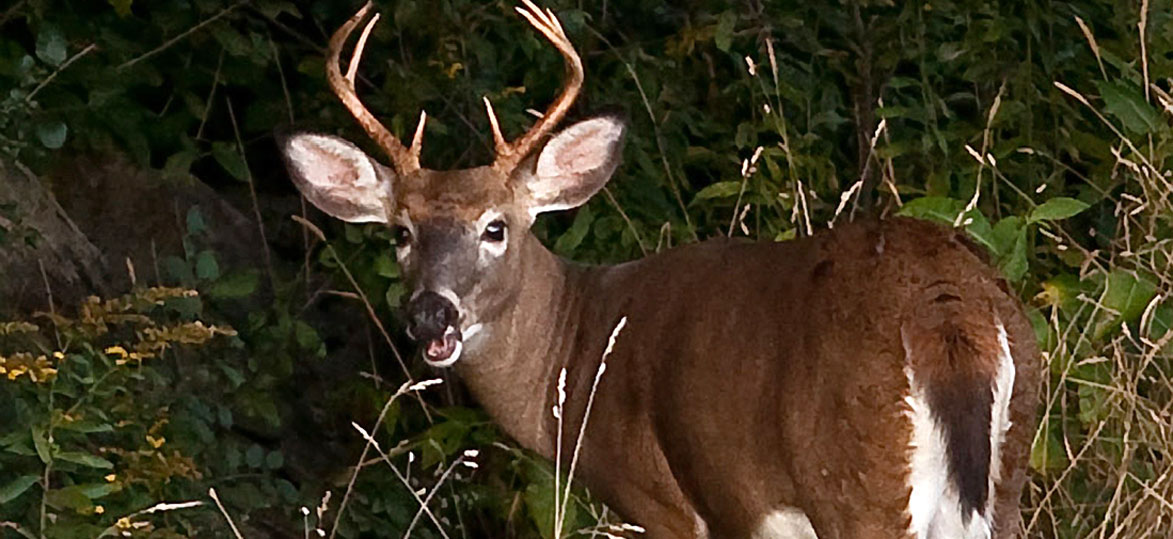
White-tailed deer (Odocoileus virginianus ) are one of the most studied and talked about species in the state. The importance Vermonters place on deer is evident in looking at the state seal. It is a deer, not an eagle or other mythical creature that sits atop the state seal!
Habitat
White-tails are very adaptable and occupy a wide range of habitat types. In Vermont, deer are found statewide. Known as a species that prefers forest "edge," they occur in highest numbers in habitats that feature a blend of large woodlots and agricultural openings. Because they are so adaptable, they also are found in more limited numbers in the expansive forests of the Green Mountains and the Northeast Kingdom.
In its northern range, deer winter areas or "deer yards" are a critically important habitat type for deer to survive through the cold winter. Only seven to eight% of Vermont's forests make up such wintering areas. An important part of a deer yard is the evergreen trees that catch the snow in their branches, thus reducing snow depth underneath. The trees also provide thermal cover that gives the deer protection from the wind. Deer may move 10 to 15 miles to go to a yard and stay in the protection of the area all winter.
Reproduction
Most white-tailed deer mate in their second year, though some females occasionally mate as young as seven months. Mating occurs between October and December and females are pregnant for 6 ½ months. Females will usually only have one baby (fawn) during her first pregnancy, but after that she may give birth to two or three. Fawns are able to walk at birth.
Diet
Fawns are nursed several times a day until they are eight-weeks old, and then they begin to eat vegetation until they're weaned by ten- weeks old.
Deer are completely vegetarian. They eat a variety of leaves, twigs, and nuts. In Vermont, a deer's diet consists of maple, ash, birch twigs and leaves. Small plants, grasses, and fruit and nuts such as apples, acorns, and beech nuts also are important foods. In order to get the nutrition from such a wide variety of food that is hard to digest, a deer has four stomachs-just like a cow. This helps deer digest food that a human couldn't possibly digest.
Management
Controlling deer numbers is important because an over-abundance of deer can cause habitat damage due to over browsing of natural forest foods; can cause damage to crops; and pose a danger on Vermont highways from deer-vehicle collisions. Part of balancing the needs of deer and the needs of people is the role of regulated hunting. Deer hunting in Vermont is a 100-year tradition. It is an enduring element in the cultural heritage of Vermont. It is a family activity (deer camps) and community activity (game suppers at fire houses and churches). Through regulated deer hunting seasons in the fall of each year, deer numbers are managed. The public harvests more than 800,000 pounds of venison each year.
Many Vermonters also enjoy viewing and photographing deer as they go on walks or rides throughout the state.
The department utilizes several population models to develop deer management recommendations. Using multiple models not only provides additional confidence in population estimates, but also allows the data to be studied further if models produce different results. Models used by the department include a doe accounting model, a sex-age-kill model, a reconstruction model, and a roadkill index. Inputs to these models include the number and age of harvested deer, birth rates obtained from roadkilled deer, winter severity, and deer sighting rates reported by hunters.
Importantly, management recommendations are based primarily on measures of deer health (birth rates, body weight, antler size) and population objectives set in the 2020-2030 Big Game Management Plan. Estimates of deer abundance are an important consideration in management recommendations, but mostly to understand population trends (increasing, stable, or decreasing) not exact numbers.
Status
Biological data on the health of deer collected during the fall's hunting season show that Vermont's deer continue to remain in good health. Maintaining a healthy deer herd is beneficial to Vermont hunters and other wildlife enthusiasts and the deer and the habitats that support them. Scientific management of the state's deer herd would not be possible without the active participation of Vermont hunters.
